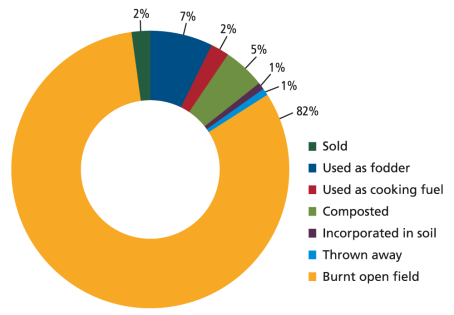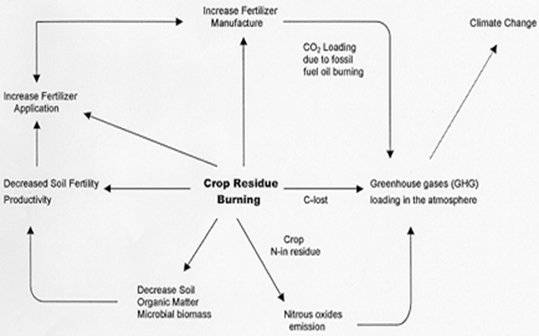Author: Dharmendra Meena
Department of agronomy, College of Agriculture, G.B. Pant University of Agriculture & Technology, Pantnagar-263145, U.K., India
Corresponding author email: dm322001@gmail.com
INTRODUCTION
Since its discovery, fire has been used by human being in both positive and negative way. In farming, fire is used to facilitate of land clearing (slash and burn cultivation of upland farming).if not for fire and burning, early farmer could not have transformed, log-over or bush land into productive crop land. The burning of crop residues in fields is one of the most significant activities of global biomass burning (excluding biofuels), and contributes substantially to air pollution. The burning of rice residue emits GHG emissions as carbon dioxide (CO2), methane (CH4), and nitrous oxide (N2O), pollutants as carbon monoxide (CO), particulate matter (PM), and toxic as polycyclic aromatic hydrocarbons (PAHs) due to the incomplete combustion process (Yadav et al, 2014). The emissions of CH4, CO, N2O, and NOx have been estimated to be about 110, 2306, 2 and 84 Gg respectively, from rice and wheat straw burning in India in the year 2000 (Gupta, et. al., 2004). Residue burning is the deliberate setting fire of the straw stubble that remains after wheat and other grains have been harvested. The carbon (C) component in stubbles is lost by burning and that the process of burning stubbles even occasionally, seriously affects the organic carbon levels of the soil. Around 80 per cent of the C in standing stubble will return to the atmosphere as CO2. Losses of carbon as CO2 to the atmosphere through burning are often only slightly greater than through natural decomposition, but they are of course immediate.
EXTEND CROP RESIDUES BURNING
Each slice depicts the percentage of farmers that disposed of crop residue in a particular manner.

FARMERS’ REASONS FOR CROP RESIDUE BURNING
- High clay content :. In some area, soil has high clay content. This type of soil prone to drainage and compaction problem, which can make burning more attractive option than tillage. Area where lot of residue is produced, this make it more difficult to incorporate the straw into the soil. For this it is the traditional practice for farmer to burn the straw in some area
- To control rats. Farmers believe that rice straw serve as hiding and breeding place for rats. Field rat is most damaging vertebrate in rice fields (Mendoza and Samson, 1999).
- Yellowing of seedling. Partially decomposed straw lead to yellowing of newly transplanted seedling. Farmers do not realized that its merely temporary. (Mendoza and Samson, 1999).
- Lack of man power. Spreading rice straw is perceived to be laborious. There is shortage of man power to deal with leftover residue of straw. Farmer burns it to save money as well as time.
- Timely sowing of next crop. After harvesting of rice, there is very less time for land preparation for the sowing of wheat. Farmer burn residue for timely sowing of next crop.
- To kill insect pest and disease pathogen. It is believed that after heating operation most of the larva of insect pest and disease are died. There attack to next crop will be less due to killing of most of the top larvae of pathogen by heating of top surface. IMPACT OF RESIDUE BURNING ON ENVIRNEMENTS

Fig. Interactive (additive) effects of Crop Residue burning in relation to Greenhouse gases (GHG) loading in the atmosphere (Mendoza and Samson, 1999).
MANAGEMENT STRATEGIES
- Incorporation of crop residues in the soil improves soil moisture and activates the growth of soil microorganisms for better plant growth. However, suitable machinery for collection, chopping and in situ incorporation of straw is required. Further initiative can made to convert the removed residues into enriched organic manure through composting.
- The best use of stubble is as animal feed by conversion of stubble into goat fodder. Converting stubble into milk and meat will add more value than using it as fuel. Humans cannot digest straw at all, but cattle, sheep, goats have four-stage stomachs that digest up to half of it. Goats have the toughest stomachs and best digestion rates. Treatment with urea, alkalis or molasses can improve the digestibility and calorific value of straw.
- Zero-till farming is another alternative which sows wheat seeds without removing the stubble. Tractor-mounted happy seeders, rotavators, and straw-reapers simultaneously cuts rice stubble and sows wheat seeds, depositing the cut stubble on top as mulch.
- The farmers should be encouraged to adopt conservation farming systems. Alternative options to manage stubble residues, particularly in high rainfall areas, are continuing to evolve.
- There is also need to develop rice varieties that are both rich in grain yield and high in straw yield. Use of such double purpose variety will help to maintain food security, farm income and improved environmental sustainability
- An all-round aggressive approach is needed on behalf of the government, scientists and farmers in the form of adoption of ‘straw management technologies’.
- Government should monitor and discourage burning of crop residue through incentives and technology transfer and utilization.
- There are various ongoing, long-term efforts at diversification of cropping techniques, such that crop residue burning can be effectively prevented. This is being attempted through cultivation of alternate crops (apart from rice/paddy and wheat) that produce less crop residue and have greater gap periods between cropping cycles.
ADVANTAGES OF BURNING
- Cheap
- Saving of man power
- Quick and easy
- Can assist weed, insect and disease control
- Reduced nitrogen tie-up DISADVANTAGES OF BURNING
- Loss of nutrients
- Loss of carbon
- Impact on soil microbes and fauna
- Reduction in soil structure (soil aggregate stability)
- Increase in erosion (wind and water)
- Can increase acidity over time CONCLUSION Biomass provides safe and reliable energy. The available paddy straw can be effectively used for power generation, which will go a long way towards overcoming the problem of disposal of crop residue and power deficit.
REFERENCES
- Gupta, P. K., Sahai, S., Singh, N., Dixit, C. K., Singh, D. P., Sharma, C., Tiwari, M. K., R. K. Gupta and Garg, S.C., 2004. Residue burning in rice-wheat cropping system: Causes and implications. Current Science 87(12), pp. 1713-1717.
- http://www.thehindu.com/opinion/op-ed/Straws-in-the-wind/article16441019.ece
- https://thelawblog.in/2016/10/31/stubble-burning-a-threat-to-the-environment/
- https://www.gov.mb.ca/agriculture/crops/crop-residue-burning-program/why-do-farmers-burn.html
- Mendoza , T.C. and Samson, T. 1999. Strategies to avoid crop residues burning in the Philippines context. REAP Canada a research report.
About Author / Additional Info: